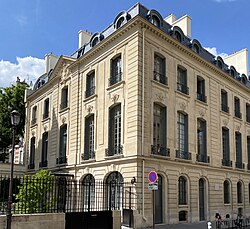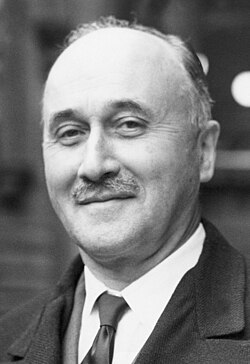General Planning Commission (France)
Topic: Finance
 From HandWiki - Reading time: 3 min
From HandWiki - Reading time: 3 min
The General Planning Commission (French: Commissariat général du Plan) was an advisory body reporting to the government of France, extant from 1946 to 2006.
History
The idea of the Commission came from exchanges between Charles de Gaulle and Jean Monnet. It was established by De Gaulle as Chairman of the Provisional Government of the French Republic, on 3 January 1946.[1]:152 Monnet was appointed its first General Commissioner, a position he held until moving to Luxembourg in 1952 as first President of the High Authority of the European Coal and Steel Community.
The General Planning Commission's first plan, the Modernization and Re-equipment Plan, was designed to spur economic reconstruction following World War II.[2]:38 Its aims were: (1) to develop national production and foreign trade, particularly in those fields where France is most favourably placed; (2) to increase productivity; (3) to ensure the full employment of manpower; (4) to raise the standard of living and to improve the environment and the conditions of national life.[3]:240 This plan is commonly known as the Monnet Plan after Jean Monnet, the chief advocate and first head of the General Planning Commission.[2]:98
In pursuit of its objectives, the General Planning Commission set production targets for 1950 according to the resources that were then expected to be available, starting with six crucial sectors: coal mining, steel, electricity, rail transport, cement, and farm machinery.[3]:247 Later oil, chemicals, fertilizers, synthetic fertilizers, synthetic fibres, shipbuilding and other sectors were added.[2]:38 The Commission's plan emphasized expansion, modernization, efficiency, and modern management practice.[4]:280 It set investment targets, and allocated investment funds.[4]:280 [2]:38
The plan’s process – focusing, prioritizing, and pointing the way – has been called "indicative planning" to differentiate it from highly directive and rigid Soviet style planning. [4] [5]:29-32
The General Planning Commission continued to produce a multi-year plan for France until 2006 when it was succeeded by the Centre d'Analyse Stratégique.[6] In 2013, the successor institution was rebranded France Stratégie.[7] A separate position of Haut-commissaire au plan (fr) was created in 2020.
Location
The Plan was headquartered in the Hôtel de Vogüé (Paris)|Hôtel de Vogüé (fr), a historical property at 18, rue de Martignac in Paris; the name "rue de Martignac" was often use metonymically to refer to the Planning Commission.[8]
The Planning Commission expanded to nearby offices at 30, rue Las Cases and 5, rue Casimir Périer, both vacated by Crédit Agricole when the latter relocated its head office to near the Gare Montparnasse in the 1960s. In 2001-2002, these extensions of the Planning Commission relocated from there to another government building in the same neighborhood at 113, rue de Grenelle.[9]
General Commissioners
- Jean Monnet, 1946-1952
- Étienne Hirsch, 1952-1959
- Pierre Massé, 1959-1966
- François-Xavier Ortoli, 1966-1967
- René Montjoie (fr), 1967-1974
- Jean Ripert (fr), 1974-1978
- Michel Albert, 1978-1981
- Hubert Prévot (fr), 1981-1984
- Henri Guillaume, 1984-1987
- Bertrand Fragonard (fr), 1987-1988
- Pierre-Yves Cossé (fr), 1988-1992
- Jean-Baptiste de Foucauld (fr), 1992-1995
- Henri Guaino, 1995-1998
- Jean-Michel Charpin (fr), 1998-2003
- Alain Etchegoyen, 2003-2005
- Sophie Boissard (fr), 2005-2006
See also
- Haut Commissariat au Plan (Morocco)
- Economic history of France
References
- ↑ Duchêne, François (1994). Jean Monnet: The First Statesman of Interdependence. New York: W.W. Norton & Company. ISBN 0-393-03497-6.
- ↑ 2.0 2.1 2.2 2.3 Milward, Alan (1987). The Reconstruction of Western Europe: 1945-1951. Taylor and Francis Group.
- ↑ 3.0 3.1 Monnet, Jean (1978). Memoirs. Garden City, New York: Doubleday & Company, Inc.. ISBN 0-385-12505-4.
- ↑ 4.0 4.1 4.2 Kindleberger, Charles (1967). "French Planning". in Millikan, Max. National Economic Planning. pp. 279-303. http://www.nber.org/chapters/c1426.
- ↑ Yergin, Daniel; Stanislaw, Joseph (1998). "Commanding Heights: Jean Monnet". pp. 29-32. https://www.pbs.org/wgbh/commandingheights/shared/minitext/prof_jeanmonnet.html.
- ↑ Centre d'analyse stratégique. "Archives: Presentation". http://archives.strategie.gouv.fr/cas/en/content/presentation.html.
- ↑ "À propos de France Stratégie". https://www.strategie.gouv.fr/propos-de-france-strategie.
- ↑ Alphonse Thélier (9 June 1967). "Du côté de la rue de Martignac". https://www.lemonde.fr/archives/article/1967/06/09/du-cote-de-la-rue-de-martignac_2635112_1819218.html.
- ↑ Claude Haut (2001). "Services du Premier ministre : Plan". https://www.senat.fr/rap/np01_37/np01_37_mono.html.
[ ⚑ ] 48°51′30″N 2°19′07″E / 48.85833°N 2.31861°E
 |
 KSF
KSF


